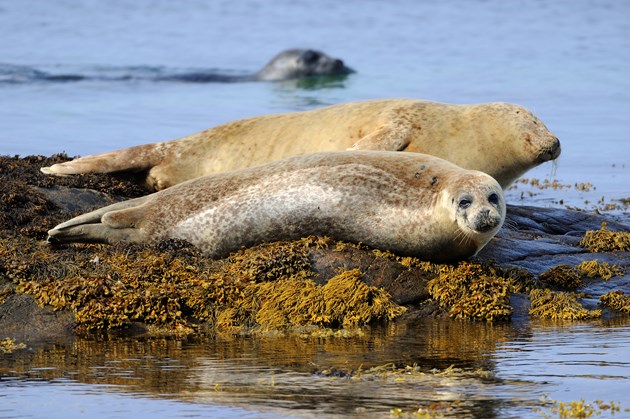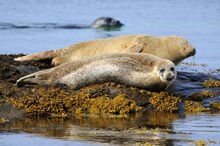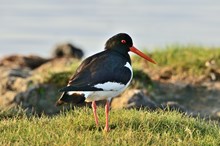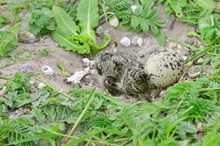01 July, 2022
Appeal to help protect Mull wildlife

Visitors to Mull are being urged to help protect wildlife this summer in response to concerns about increased disturbance at island hotspots.
The growth in wildlife tourism on the island in recent years has been a great success story, with visitors flocking to see and photograph species such as otters, sea eagles and seals.
However, increased numbers has led to concerns that wildlife is being negatively impacted at some popular locations.
This includes reports of disturbance to otters from photographers which could disrupt feeding and in extreme cases lead to abandonment of holts.
Concerns have also been raised about the impact of visitors on ground-nesting birds such as terns and oystercatchers at locations including port Na Ba at Croig; Langamull; Killiechronan; Scallastle Bay; Salen Bay and even the Island of Glas Eilleanan in the Sound of Mull which is designated as an SPA for its common tern. Continued or repeated disturbance can leave young birds vulnerable to the weather and to predation.
Salen Bay is also a haul-out site for harbour seals which have been seen being flushed off the rocks by overly-enthusiastic visitors, which can lead to pups being crushed in the resulting stampede or separated from their mothers, upon whom they are dependent.
In response to the concerns, NatureScot, Police Scotland and Mull and Iona Ranger Service have come together to urge visitors to enjoy watching wildlife responsibly.
Sally Weaser, NatureScot’s Operations Officer for Mull, said: “Wildlife watching along our coasts is an amazing experience which can help more people connect to nature and provide a vital boost to tourism and local economies. However, particularly in busy and popular places, it’s crucially important to take care that animals and birds are not disturbed.
“We’d encourage visitors to Mull (and beyond) to familiarise themselves with the Scottish Outdoor Access Code and the Scottish Marine Wildlife Watching Code which provide lots of tips and advice to help people minimise disturbance and stay within the law. Follow any local signs, give wildlife lots of space and move away if you spot any signs of disturbance. It’s also vitally important that dogs are kept under close control, especially at this sensitive time of year when ground-nesting birds are breeding.
“By enjoying wildlife watching and photography responsibly, we can ensure that the animals and birds that make this island so special continue to thrive.”
PC David Armstrong, Wildlife Crime Liaison Officer for Argyll and West Dunbartonshire Division, said: ‘While it’s great that people are taking an active interest in Scottish wildlife, unnecessary disturbance can have a severe impact on an species ability to survive, particularly when there are dependent young and the impact from disturbance is cumulative. In most cases the law affords species protection from disturbance (or harassment in the case of seals) and offences can attract fines of up to £40,000. Any incidents of disturbance should be reported to Police Scotland on 101.”
Jan Dunlop, Countryside Ranger Manager for the Mull and Iona Ranger Service, said: “We love that Mull is recognised for its amazing wildlife and we are glad that people want to enjoy it with us but we must ensure that the wildlife is allowed to thrive without disturbance. Each incidence of even a small amount of disturbance can accumulate and become a big problem. We want to help our visitors enjoy what Mull has to offer without detriment to this unique place and the wildlife that lives here.”
ENDS
Contact information
- Name
- NatureScot Media
- Telephone
- 0131 316 2655
- media@nature.scot
Notes to editors
The Scottish Marine Wildlife Watching Code includes advice and tips such as:
- Follow any locally available advice or signage about avoiding disturbance to wildlife.
- Keep your dog under close control at all times as they can cause great disturbance. Do not leave litter. Follow the Scottish Outdoor Access Code.
- Use wildlife watching hides wherever possible.
- Keep a good lookout and don’t get too close. Use binoculars or a telescope to get better views.
- As soon as you see wildlife, assess the situation. What are the animals doing? Where are they going? How can I avoid disturbing them?
- Let the animals decide how close they want you to be. If you see signs of disturbance (such as “heads up” responses, alarm calls, sudden movements or aggressive behaviour) then you should move away and if possible take an alternative route or wait for the animals to move on.
- If you are passing close to wildlife, do so slowly and cautiously. Make sure that your movements are steady and predictable, and do not approach directly.
- Avoid surrounding or corralling the animals. If other people are watching the same animals, or you are in a group, try to ensure that you all stay together and to one side. Remember that with more people the likelihood of disturbance will be greater.
- Do not chase animals. Let them go if they move away.
- Do not feed or touch birds or other wild animals.
- Avoid using flash photography – check the default setting on your camera.
- Move away from wildlife as quietly and carefully as you can – your exit should be as careful as your approach.
- Take extra care during sensitive times of year in places where animals may be feeding, resting, breeding or with their young:
- Be careful not to scare birds off nests or trample burrows/nests.
- Do not intentionally divide or put up flocks of birds or flush seals into the sea.
- Do not approach otter holts (dens) closely, and avoid blocking routes to and from the sea.
- Be careful not to split up groups or mothers and young, and never approach apparently lone young animals.
- If camping on the coast, follow the Scottish Outdoor Access Code’s advice on camping responsibly. Avoid pitching your tent close to seal colonies, otter holts or sites used by birds for nesting or roosting.
NatureScot is Scotland's nature agency. We work to enhance our natural environment in Scotland and inspire everyone to care more about it. Our priority is a nature-rich future for Scotland and an effective response to the climate emergency. For more information, visit our website at www.nature.scot or follow us on X at https://x.com/NatureScot
’S e NatureScot buidheann nàdair na h-Alba. Bidh sinn a’ neartachadh àrainneachd na h-Alba agus a’ brosnachadh dhaoine gu barrachd suim a chur ann an nàdar. Tha e mar phrìomhachas againn gum bi nàdar na h-Alba beairteach agus gun dèilig sinn gu h-èifeachdach le èiginn na gnàth-shìde. Tha an tuilleadh fiosrachaidh aig www.nature.scot no air X aig https://x.com/NatureScot



